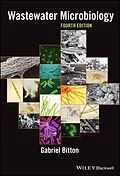Wastewater Microbiology focuses on microbial contaminants found in wastewater, methods of detection for these contaminants, and methods of cleansing water of microbial contamination. This classic reference has now been updated to focus more exclusively on issues particular to wastewater, with new information on fecal contamination and new molecular methods. The book features new methods to determine cell viability/activity in environmental samples; a new section on bacterial spores as indicators; new information covering disinfection byproducts, UV disinfection, and photoreactivation; and much more. A PowerPoint of figures from the book is available at ftp://ftp.wiley.com/public/sci_tech_med/wastewater_microbiology.
Autorentext
Gabriel Bitton is Professor Emeritus of Environmental Microbiology and Toxicology at University of Florida, Gainesville.?An international authority in water-associated microbial contamination, this is the fourth edition of his classic work and will be followed by a new work on Drinking Water Microbiology.
Klappentext
The classic text in wastewater microbiology, updated for a changing field
The field of water and wastewater microbiology has advanced dramatically in recent years, spurred by growing awareness about health and environmental impacts. These advances have been thoroughly integrated into the Fourth Edition of Wastewater Microbiology, widely regarded as the field's definitive text reference. In this Fourth Edition, the book focuses more exclusively on issues particular to wastewatermicrobial contaminants found in wastewater, methods of detection for these contaminants, methods of cleansing wastewater of microbial contamination, and the health effects of microbial contaminationwith new information on fecal contamination and new molecular methods.
The many advances in wastewater microbiology have all been thoroughly integrated into this text, including:
-
A new chapter on microbial source tracking of fecal contamination of receiving waters
-
Recent information on disinfection methods such as UV disinfection and photoreactivation, solar radiation, photocatalysis, ultrasonic energy, ultra-high hydrostatic pressure, membrane filtration, and the use of nanomaterials
-
New methods for determining cell viability/activity in environmental samples
-
An expanded section on molecular methods
-
A new section on bacterial spores as indicators
-
Advances in the study of the activated sludge system as well as an expanded section on Enhanced Biological Phosphorus Removal (EBPR) in activated sludge
-
A new section on bioelectrochemical wastewater treatment, which is based on the use of microorganisms for the production of bioelectricity
In addition, the text includes updated content on risk assessment, methanogen classification, and methodology and inhibition of anaerobic digestion. Information concerning the growing fields of epidemiology and public health microbiology has been similarly expanded.
Complete with end-of-chapter questions, this is the single go-to reference in wastewater microbiology for advanced undergraduates, graduate students, and professionals in sciences and engineering in the fields of microbiology and environmental/wastewater engineering and treatment, as well as for public health officials.
Zusammenfassung
Wastewater Microbiology focuses on microbial contaminants found in wastewater, methods of detection for these contaminants, and methods of cleansing water of microbial contamination. This classic reference has now been updated to focus more exclusively on issues particular to wastewater, with new information on fecal contamination and new molecular methods. The book features new methods to determine cell viability/activity in environmental samples; a new section on bacterial spores as indicators; new information covering disinfection byproducts, UV disinfection, and photoreactivation; and much more. A PowerPoint of figures from the book is available at ftp://ftp.wiley.com/public/sci_tech_med/wastewater_microbiology.
Inhalt
Preface to the Fourth Edition ix
Preface to the Third Edition xi
Preface to the Second Edition xiii
Preface to the First Edition xv
Part A. Fundamentals of Microbiology 1
1. The Microbial World 3
2. Microbial Metabolism and Growth 51
3. Role of Microorganisms in Biogeochemical Cycles 83
Part B. Public Health Microbiology 119
4. Pathogens and Parasites in Domestic Wastewater 121
5. Microbial Indicators of Fecal Contamination 173
6. Microbial Source Tracking 197
7. Wastewater Disinfection 217
Part C. Microbiology of Wastewater Treatment 267
8. Introduction to Wastewater Treatment 269
9. Activated Sludge Process 281
10. Bulking and Foaming in Activated Sludge Plants 319
11. Processes Based on Attached Microbial Growth 353
12. Waste Stabilization Ponds 369
13. Sludge Microbiology 383
14. Anaerobic Digestion of Wastewater and Biosolids 409
15. Biological Aerosols and Bio-odors from Wastewater Treatment Plants 437
Part D. Biotechnology In Wastewater Treatment 465
16. Pollution Control Biotechnology 467
Part E. Fate and Toxicity of Chemicals In Wastewater Treatment Plants 501
17. Fate of Xenobiotics and Toxic Metals in Wastewater Treatment Plants 503
18. Toxicity Testing in Wastewater Treatment Plants Using Microorganisms 533
Part F. Microbiology and Public Health Aspects of Wastewater Effluents and Biosolids Disposal and Reuse 553
19. Public Health Aspects of Wastewater and Biosolids Disposal on Land 555
20. Public Health Aspects of Contamination of Recreational Waters with Wastewater 581
21. Wastewater Reuse 599
References 619
Index 763
